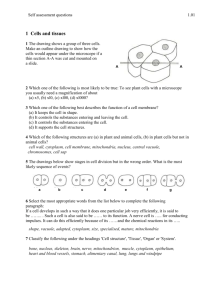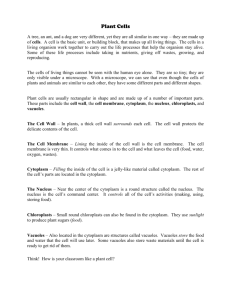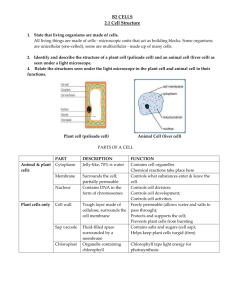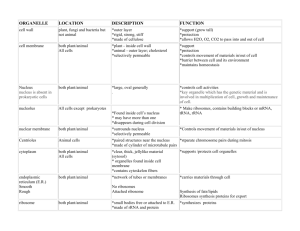4-1: What are cells
advertisement
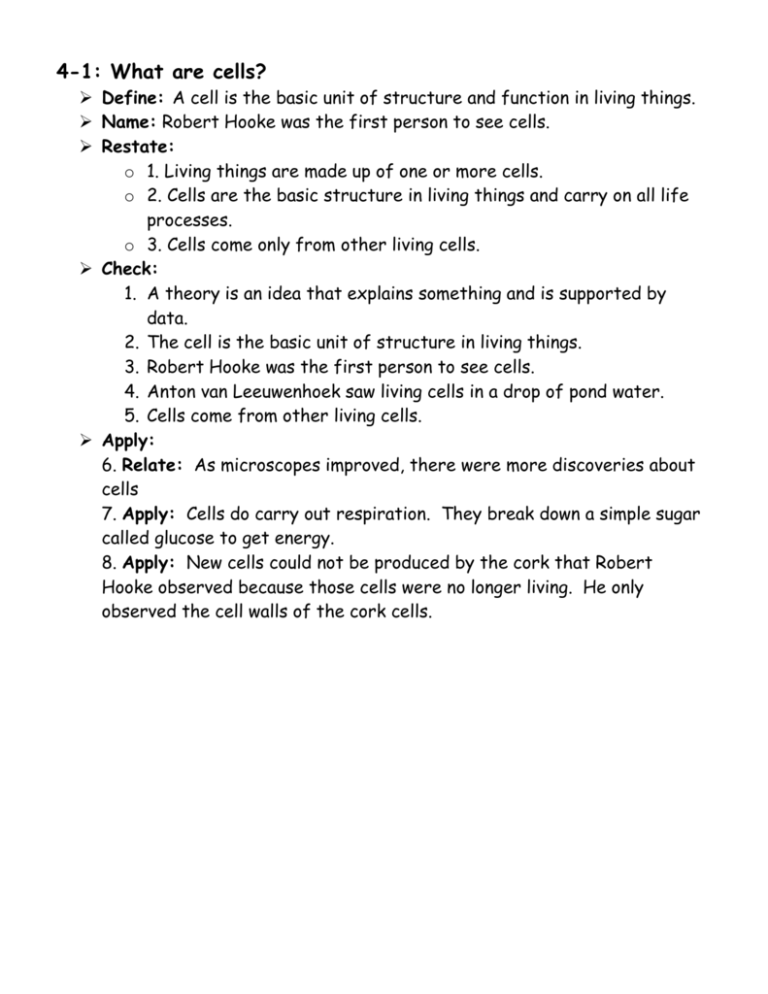
4-1: What are cells? Define: A cell is the basic unit of structure and function in living things. Name: Robert Hooke was the first person to see cells. Restate: o 1. Living things are made up of one or more cells. o 2. Cells are the basic structure in living things and carry on all life processes. o 3. Cells come only from other living cells. Check: 1. A theory is an idea that explains something and is supported by data. 2. The cell is the basic unit of structure in living things. 3. Robert Hooke was the first person to see cells. 4. Anton van Leeuwenhoek saw living cells in a drop of pond water. 5. Cells come from other living cells. Apply: 6. Relate: As microscopes improved, there were more discoveries about cells 7. Apply: Cells do carry out respiration. They break down a simple sugar called glucose to get energy. 8. Apply: New cells could not be produced by the cork that Robert Hooke observed because those cells were no longer living. He only observed the cell walls of the cork cells. 4-2: What are the main cell parts? Name: The three main cell parts are the cell membrane, the cytoplasm, and the nucleus Infer: There would be no control center to control all of the life processes of the cell. Describe: Most of the cells activities occur in the cytoplasm. List: The cell membrane protects the inside of the cell, gives support and shape to the cell, and controls the movement of materials in and out of the cell. Check: 1. All the life processes of the cell are controlled by the nucleus. 2. The cell membrane is also called the plasma membrane. 3. The three main parts of the cell are the nucleus, the cell membrane, and the cytoplasm. 4. The cell membrane controls the movement of material into and out of the cell. 5. Most of the cell is made up of cytoplasm. Apply: 6. Apply: The nucleus controls respiration. 7. Infer: The nuclear membrane has the same functions as the cell membrane; protection, gives shape, controls movement of materials in and out of the nucleus. 8. Model: A = Cytoplasm; B = Nucleus, and C = Cell Membrane 4-3: What are other cell parts? Define: Organelles are small structures that float in the cytoplasm that do special jobs. Explain: A cell needs energy to carry out all of its life processes. List: Vacuoles can store food, water, and waste. Infer: The ribosomes can be called a “protein factory” because they are producing proteins. Describe: The transports tubes (endoplasmic reticulum) are used to move materials around the cell. Check: 1. The “powerhouses” of the cell are ribosomes. False – mitochondria 2. Small structures in the cytoplasm are organelles. True 3. Ribosomes make proteins. True 4. Liquid-filled spaces are mitochondria. False – vacuoles 5. Ribosomes are small rice-shaped structures. False – round Apply: 6. Compare: Railroad = Transport Tubes (Endoplasmic Reticulum) Cabinet = Vacuoles Battery = Mitochondria Electric Company = Mitochondria 7. There are probably more mitochondria in muscle cells than in skin because the muscle cells need more energy. 8. 4-4: How do plant and animal cells differ? Name: Most of the cell wall is made of cellulose. Observe: The plant cell in the above diagram has two vacuoles. Explain: Most plants are green because plant cells contain chloroplasts which contain a green substance called chlorophyll. Check: 1. Large plants do not need a skeleton because they have thick cell walls made of cellulose. 2. The cell walls protect the plant cells, give them shape, and they give the plant support. 3. Chloroplasts are the structures where plants make their own food by photosynthesis. 4. Cellulose is a hard, nonliving material that makes up the cell wall of a plant cell. 5. There are more vacuoles in animal cells and they are smaller in animal cells. Plant cells have one large vacuole (sometimes two). 6. Plants need chlorophyll to make their food. Apply: 7. Compare: a. Plant and animal cells both have a cell membrane, a nucleus, cytoplasm, mitochondria, and vacuoles. b. Plant cells have a cell wall and chloroplasts and animal cells do not. Plant cells have one or two large vacuoles and animal cells have several small vacuoles. 8. Analyze: The following organisms contain cellulose: o a. pine tree o d. fern o e. grass 9. Wood is mainly a nonliving material because it is made up of the hard material called cellulose. Cellulose is the material making up the cell walls of plant cells.





